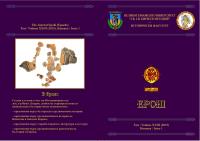Мечът от Sfântu Gheorghe, окръг Covasna (1943)
The sword of Sfântu Gheorghe, Covasna County (1943)
Author(s): Valeri YotovSubject(s): History, Recent History (1900 till today), WW II and following years (1940 - 1949)
Published by: Великотърновски университет „Св. св. Кирил и Методий”
Keywords: sword; invasion; Sfântu Gheorghe; Bulgarians; Hungarians; Transylvania; Central Southern Carpathians
Summary/Abstract: The author pointed his attention again on the interesting findings of 1943 in Sfântu Gheorghe, Covasna County in Rumania: a destroyed grave and the discovered inside it sword. According to the hypothesis of A. Kiss and R.R. Heitel, the grave was connected with the early penetration of Hungarians in Transylvania. The author launched a new opinion on this case, using several available data connected with this topic. First of all, most authors who investigated the region of Central Southern Carpathians agree that there are no early Magyarian necropolises (of first half of 10th century) found there. Secondary, the ritual characteristic of the 1943 grave in Sfântu Gheorghe is not typical only for the Magyars in the 9th – 10th centuries, but it is typical also a for other ethnic groups and people who lived in the region before them, among them – Avars and Proto-Bulgarians. It is interesting that until now there was no attempt to connect the 1943 Sfântu Gheorghe grave with the well documented evidence: both by historical sources and finds of material culture of Bulgarian presence in that region as well as cemeteries. They are mentioned by a numbers of authors with the term Bulgarian expansion in Transylvania the 9thand 10th centuries. The author totally agreed with the thesis that the sword in the above mentioned grave of 1943 in Sfântu Gheorgheis of Byzantine origin but this is another find which evidenced the Bulgarian invasion in this region during that period.
Journal: Епохи
- Issue Year: 23/2015
- Issue No: 1
- Page Range: 161-166
- Page Count: 6
- Language: Bulgarian

